Making sausage at home isn’t hard. The basic thing to remember is that sausage is essentially just ground meat mixed with salt and seasonings of some kind. It doesn’t have to be stuffed into casing and it doesn’t even have to be formed into patties. The basic idea is to take tough cuts of meat and grind them in order to make them easier to cook and eat. You can make perfectly serviceable sausage by buying ground pork, beef, lamb or poultry and then spicing it yourself.
But of course, the more of the process you get involved in, the better the end result and the more control you’ll have over the whole process. You don’t need a huge amount of equipment but a meat grinder is helpful as is some kind of stuffing attachment if you want to make links. I have a Kitchen Aid mixer and use their grinder and sausage stuffing attachment which is fine. The grinder isn’t ideal in that the knife blades are difficult to sharpen and sometimes the results seem less like ground than slightly torn or pulverized, but it’s OK for most applications. If you really get serious, get a good grinder and take good care of the grinding knife.
If there is one primary rule in making sausages, it’s to keep everything very cold (bordering on or slightly freezing). This includes the grinder and stuffer, as well as the meat. In fact, the meat should be slightly frozen to cut a good grind and to keep from getting “smear.” Smear is the sausage maker’s nightmare and it’s to be avoided at all costs. Most sausage is about 25-30% fat. Smear occurs when the fat gets broken down and is smeared into the meat. The fat separates and when the sausage cooks, the fat and meat separate resulting in stringy, pasty meat and pools of fat (plus they make the sausage shrink and you can see big pools of fat in the casings, yuck). If you keep everything during grinding, mixing and stuffing you’ll be fine, but that’s why sausage making is best done in a few steps: grind the meat and then re-chill it in the freezer; mix the meat and the spices and then re-chill it; and then stuff them.
Most home grinders come with two different size plates: 3/8 and 1/4 inch. 3/8 is the better grind for coarser styles like Italian sausage, chorizo, etc, but I generally prefer the 1/4 plate for brats. If you can only choose one size, though, go with the 3/8 grind which is like a chili grind from the supermarket. If you want really coarse, rustic sausages, hand cut a portion of the meat into tiny cubes. I normally will hand cut about 1/3 of the meat for a coarser more rustic look. 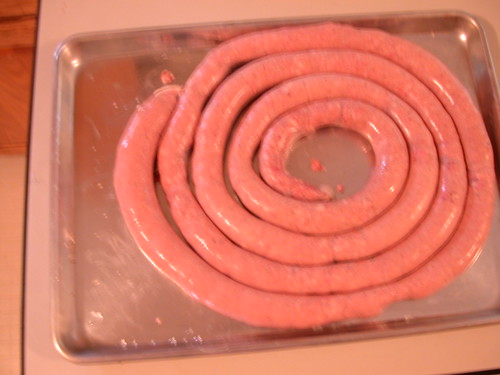
Salt is essential for any sausage and quantities vary but a good rule of thumb is one teaspoon of salt per pound of meat, but some varieties will be considerably higher. There’s a big debate about “pink salt” because it contains nitrites. If you’re going to cold smoke your sausages for any length of time, use nitrates, because botulism is a real threat and scary reality. Cold smoking normally means smoking food between 80and 100 degrees. Botulism requires moisture and an absence of oxygen to grow, and a cold smoker is a perfect environment for it. If you wouldn’t leave thawed meat out on the kitchen counter on a hot summer day for 8-12 hours, then you probably should add pink salt to your sausage. Pink salt is premeasured and generally contains 94% salt and 6% nitrite. One level teaspoon per five pounds of meat is plenty to keep botulism and other nasties at bay. If you’re going to make sausage that’s going right onto the grill or that will be hot smoked at higher temperatures don’t bother. 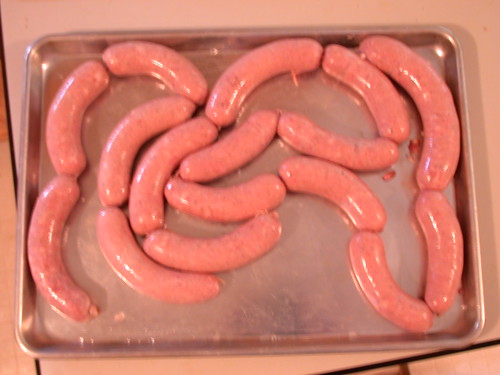
When you get started it pays to use some recipes at first until you’ve done a few batches, at which point I would encourage you to go hog wild and add whatever sounds good. There are several great resources to check out. For supplies, The Sausage Maker and Butcher and Packer are both reputable and reliable sources. For books, check out Michael Ruhlman and Brian Polcyn’s Charcuterie which is a masterpiece for both beginners and advanced sausage makers. A great book for beginners is Bruce Aidell’s Complete Sausage Book, which will teach you to make sausages and will also give you recipes to use them in. The old school bible for sausage makers (which is geared more to professionals, but is well worth tracking down) is Rytek Kutas’s Great Sausage Recipes and Meat Curing. The recipes are generally for 10, 25 and 100 pound batches, but they scale down nicely. There’s a great web site by a gentleman named Len Poli which is a terrific resource as well. 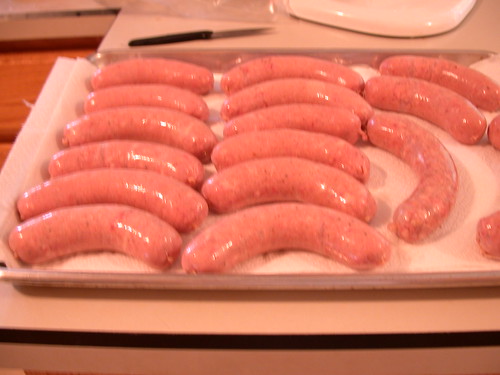
A few more tips if you haven’t tried this yet. Start with a basic fresh sausage, whether it’s a breakfast variety, sweet Italians, Brats, etc. Dried cured sausages like salami are very difficult and require temperature and humidity control and can require bacterial cultures as well. Emulsified sausages like weisswurst and frankfurters are do-able but have their own special challenges and aren’t the best type to try for your first batch. I normally make pork sausage, and I generally some cut from the shoulder (shoulder roasts or Boston butts are great). If you want beef, go with chuck. These cuts will give you enough fat without having to find fat back, which is a special order unless you have a really good butcher. If you use chicken, use thighs and tried to use some skin as well or they may be a bit dry.
So give it a try and you’ll likely be well rewarded by your efforts.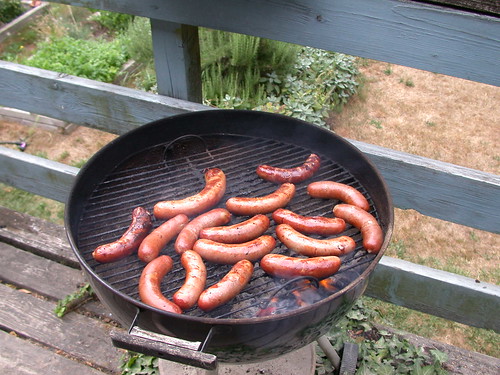
Wednesday, August 29, 2007
A Sausage Making Primer
Posted by
Bill
at
4:47 PM
![]()
![]()
Labels: bruce aidell, charcuterie, len poli, michael ruhlman, rytek kutas, sausage
Subscribe to:
Post Comments (Atom)
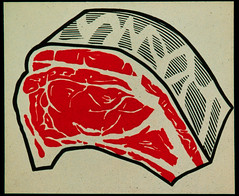
No comments:
Post a Comment